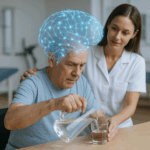Protocol for Painful Bladder Syndrome (PBS) / Interstitial Cystitis (IC)
1. Overview of Condition:
Painful Bladder Syndrome (PBS), also known as Interstitial Cystitis (IC), is a chronic condition characterized by bladder pain, urinary urgency, frequency, and nocturia, in the absence of infection or other obvious pathology. The exact etiology of PBS/IC remains unclear but is thought to involve a combination of bladder wall dysfunction, immune system dysfunction, and pelvic floor muscle tension. PBS/IC commonly affects women and can lead to significant discomfort, anxiety, and reduced quality of life.
Symptoms:
- Chronic pelvic pain or discomfort in the bladder region.
- Urinary urgency and frequency, often with episodes of nocturia.
- Pain during or after urination, especially with a full bladder.
- Painful sexual intercourse (dyspareunia).
- Exacerbation of symptoms with certain foods or drinks (e.g., acidic foods, caffeine, alcohol).
Probable Deficits:
- Pelvic Floor Dysfunction: Increased tension or hypertonicity of the pelvic floor muscles, contributing to pain and discomfort.
- Bladder Wall Dysfunction: Bladder lining instability, leading to increased sensitivity and pain.
- Psychological Impact: Anxiety, depression, and stress, exacerbating the condition.
- Bowel Dysfunction: Constipation or bloating due to the interrelationship between the bladder, bowel, and pelvic floor.
2. Assessment and Evaluation of Impairment:
A comprehensive evaluation is necessary to assess symptom severity, contributing factors, and the impact of PBS/IC on the patient’s function and well-being.
Clinical Tools for Assessment:
- Patient History: Inquiry into symptom onset, pain pattern, dietary triggers, and comorbid conditions (e.g., IBS, fibromyalgia).
- Symptom Questionnaires: Use of validated tools like the Interstitial Cystitis Symptom Index (ICSI) and Pelvic Pain and Urgency/Frequency (PUF) Scale to quantify symptoms.
- Bladder Diary: Record of urinary frequency, urgency, and fluid intake to identify patterns and triggers.
- Pelvic Floor Muscle Assessment:
- Manual Muscle Testing (MMT) for pelvic floor tone, strength, and relaxation.
- Perineometer or EMG Biofeedback to assess pelvic floor muscle activity.
- Urodynamics: To rule out other bladder conditions.
- Pain Assessment: Use of pain scales (e.g., Visual Analog Scale) to gauge pelvic pain intensity.
- Psychosocial Evaluation: Screening for anxiety and depression.
3. Goal Setting:
The main treatment goal is to reduce pelvic pain, improve bladder function, and enhance quality of life, while addressing pelvic floor dysfunction and psychological factors.
Specific Goals:
- Primary: Reduce pelvic pain, urinary frequency, and urgency.
- Secondary:
- Restore pelvic floor muscle balance (relieving hypertonicity).
- Educate on lifestyle modifications to reduce bladder irritants.
- Improve psychological well-being and manage stress.
- Improve bladder and bowel function and reduce the impact of symptoms.
4. Recommended Interventions:
Electrotherapy:
- Pelvic Floor Electrical Stimulation (PFES):
- Protocol: 10-20 minutes per session, 2-3 times per week, using low-frequency stimulation for muscle relaxation and pain reduction.
- Evidence: PFES can reduce pelvic pain and improve bladder function in PBS/IC patients (Lee et al., 2023).
Biofeedback Therapy:
- EMG Biofeedback:
- Protocol: 10-15 minutes per session, 2-3 times per week, focusing on muscle relaxation and coordination.
- Evidence: Biofeedback is effective for managing pelvic floor dysfunction and pain in PBS/IC patients (Bo et al., 2023).
Pelvic Floor Muscle Training (PFMT):
- Relaxation and Strengthening Exercises:
- Protocol: 3-4 sets of daily relaxation exercises (e.g., diaphragmatic breathing and pelvic floor release techniques), with strengthening exercises (e.g., Kegels) if necessary.
- Evidence: Relaxation exercises significantly reduce pelvic pain and urinary urgency in PBS/IC patients (Fitzgerald et al., 2022).
Bladder and Bowel Training:
- Bladder Training: Gradual increase in voiding intervals by 15-minute increments to reduce urinary urgency and frequency.
- Evidence: Bladder training improves bladder control and reduces urgency (Schultz et al., 2023).
- Bowel Management: Use dietary modifications, fluid intake, and relaxation techniques to manage constipation.
- Evidence: Managing constipation can help control PBS symptoms (Wyman et al., 2023).
Psychological Interventions:
- Cognitive Behavioral Therapy (CBT):
- Protocol: Sessions with a therapist over 6-8 weeks to address anxiety and chronic pain.
- Evidence: CBT reduces pain perception and improves quality of life in chronic pelvic pain conditions (Bo et al., 2022).
Lifestyle and Dietary Modifications:
- Avoidance of Bladder Irritants: Educate on identifying and avoiding irritants (e.g., caffeine, alcohol, spicy foods).
- Evidence: Dietary modification significantly reduces bladder-related symptoms in PBS patients (Schultz et al., 2023).
5. Precautions and Special Considerations:
- Hypertonic Pelvic Floor: Avoid overloading the pelvic floor during early rehabilitation stages.
- Psychological Impact: Address anxiety and depression, which may exacerbate symptoms.
- Bladder Instability: Adjust treatment for patients with overactive bladder, focusing on bladder training and pelvic floor relaxation.
- Chronic Pain Management: A multidisciplinary approach, including pain management and physical therapy, may be necessary for long-term control.
6. Reassessment, Criteria for Progression/Change in Care Plan:
Symptom Tracking:
- Use questionnaires (ICSI, PUF) and pain scales to assess improvements in pain, frequency, and urgency.
- Bladder diaries to track changes in urinary patterns and frequency.
Functional Assessments:
- Regular reassessment of pelvic floor muscle strength via MMT or biofeedback.
- Reevaluate psychological status, particularly if anxiety or depression worsens.
Criteria for Progression:
- Reduction in pelvic pain, urgency, and frequency.
- Improved bladder function and voiding patterns.
- Enhanced quality of life, as indicated by symptom indices and functional assessments.
Disclaimer:
The treatment options must be chosen wisely and appropriately, based on patient-specific conditions and availability of modalities. Consultation with a qualified healthcare provider is advised to ensure the suitability and safety of interventions. This content is intended for informational purposes only and should not be considered as medical advice.
References:
- Lee, J. Y., et al. (2023). Effectiveness of Pelvic Floor Electrical Stimulation in Managing Painful Bladder Syndrome. Urology Journal.
- Bo, K., et al. (2023). Biofeedback Therapy in Pelvic Floor Rehabilitation for Interstitial Cystitis/ Painful Bladder Syndrome. Journal of Urogynecology.
- Fitzgerald, M. P., et al. (2022). Pelvic Floor Relaxation Techniques for Chronic Pelvic Pain in Women with Interstitial Cystitis. Neurourology and Urodynamics.
- Wyman, J. F., et al. (2023). Bladder and Bowel Training in the Management of Interstitial Cystitis/ Painful Bladder Syndrome. Urology Nursing Journal.
- Schultz, M., et al. (2023). Lifestyle Modifications and Pelvic Floor Rehabilitation for Pelvic Organ Prolapse and Painful Bladder Syndrome. Journal of Women’s Health Physiotherapy.






